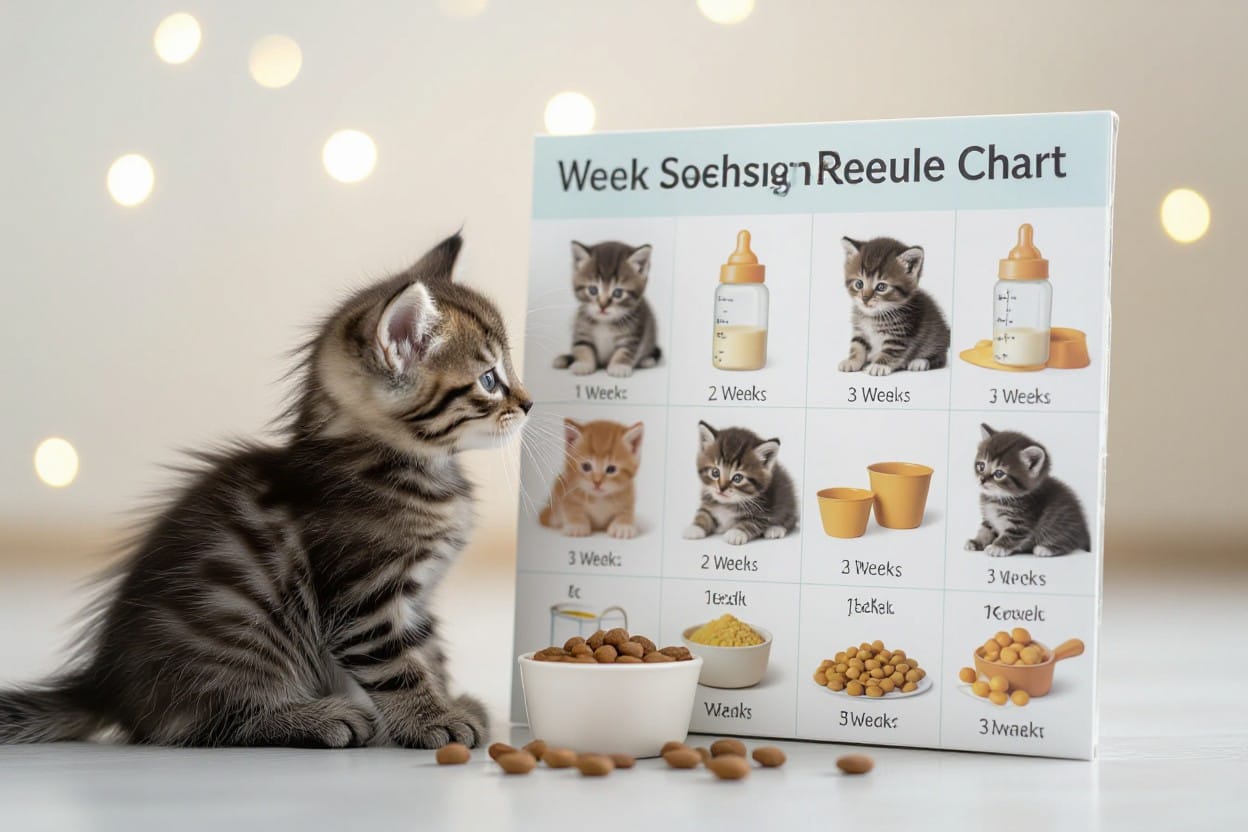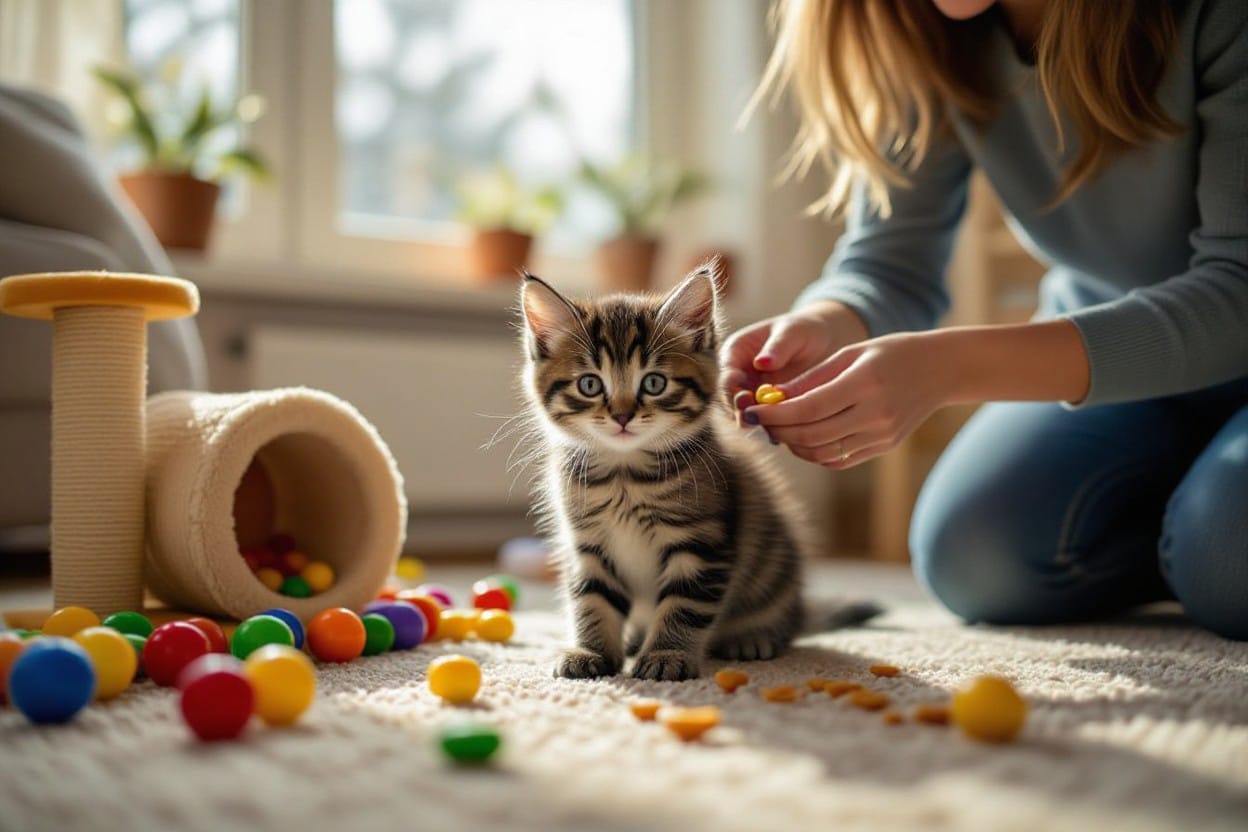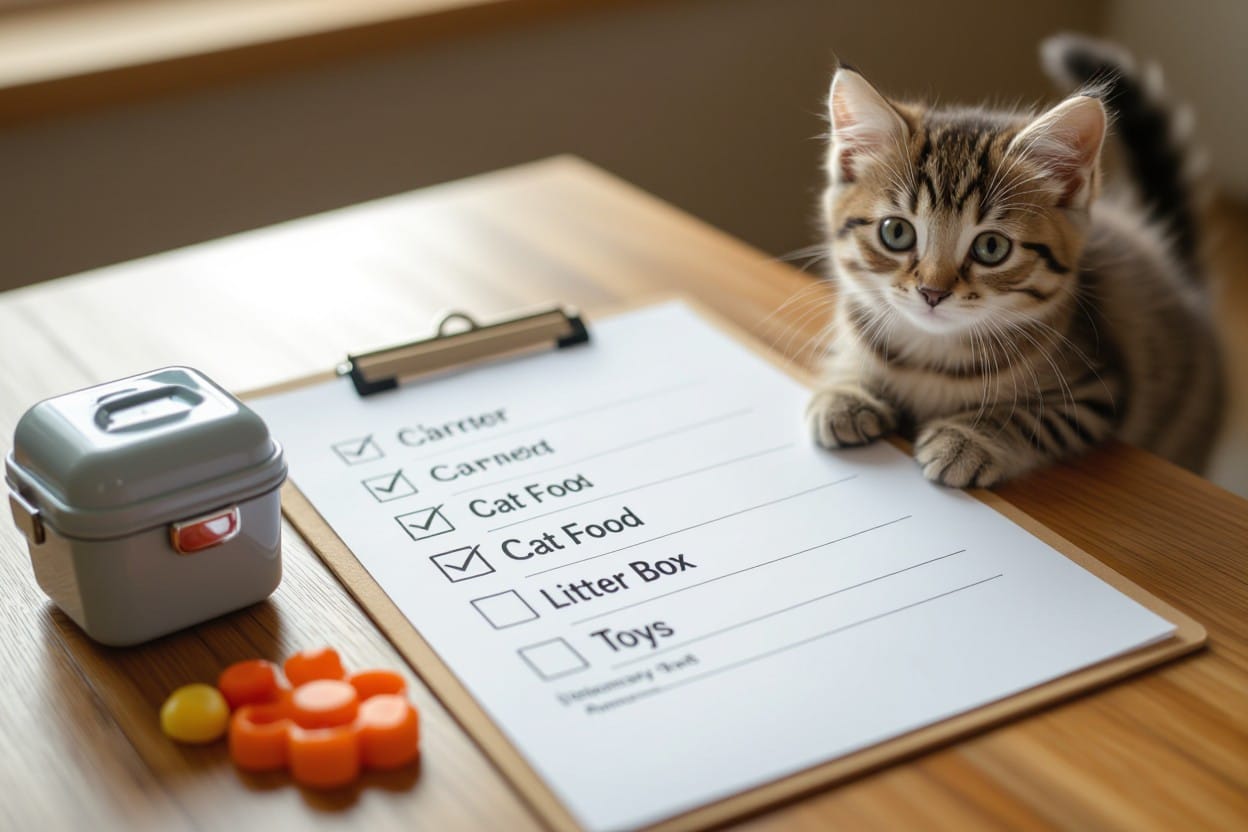With a month-by-month plan, you guide your kitten’s health, behavior, and social growth from birth to one year. Use this kitten care guide to track feeding, vaccines, and spaying/neutering and regular vet checks, promote playful kittens and early socialization, and monitor milestones in kitten development. Be vigilant about toxic plants, small objects, and unprotected windows that can cause serious harm, and prioritize enrichment, safe play, and steady weight gain to set your cat up for a healthy life.
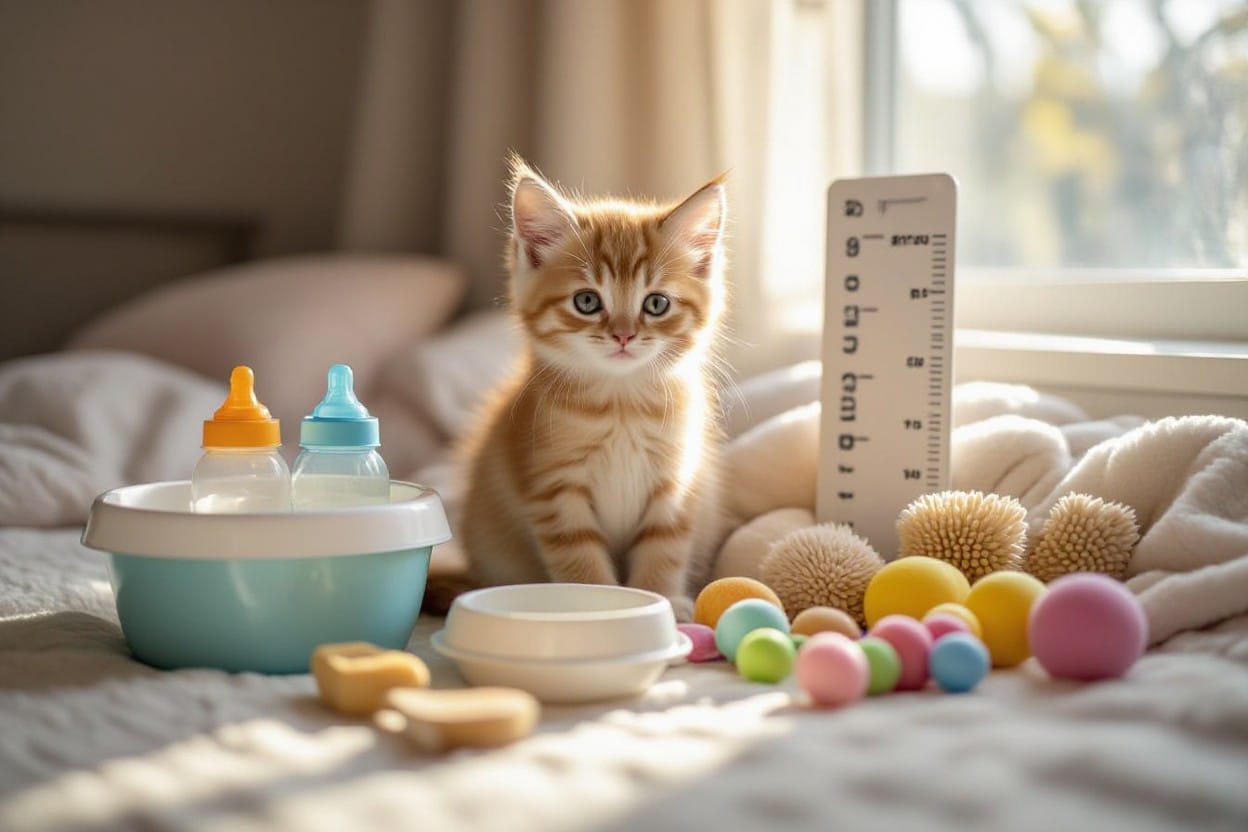
Key Takeaways:
- Early kitten socialization (starting 2–9 weeks and continuing) through gentle handling and exposure to people, sounds, and safe experiences builds confident, well-adjusted cats.
- Support playful kittens with daily interactive play, varied toys, and short sessions that mimic hunting to develop coordination, mental enrichment, and stronger bonds.
- Follow a kitten care guide timeline for nutrition, vaccinations, deworming, litter training, spay/neuter, and regular vet checks across 0–12 months to promote healthy kitten development.
The Critical First Year
Importance of Early Development
Socialization between roughly 2–9 weeks sets long-term behavior: handle your kitten gently for 5–10 minutes multiple times daily, introduce 5–10 different people, brief household noises (vacuum for 10–20 seconds), and supervised exposure to leashed dogs if available. Kittens exposed to varied stimuli during this window are far more likely to grow into confident, playful kittens that accept grooming, vet visits, and interactive play without excessive fear or aggression.
Early tactile play and positive feeding interactions also build tolerance for handling and reduce stress-related behaviors later. Track progress with simple metrics—for example, by 8–12 weeks many kittens will approach you for petting and play; if your kitten consistently withdraws, schedule targeted socialization sessions and consult your vet or a behaviorist.
Understanding Growth Phases
Expect distinct stages: neonatal (0–2 weeks) when kittens double birth weight and rely entirely on milk; transitional (2–3 weeks) with eyes opening and first steps; socialization (3–9 weeks) where play-fighting, litter learning, and human bonding accelerate; juvenile (9 weeks–6 months) marked by rapid physical growth and increased appetite; adolescence (6–12 months) when sexual maturity and independence behaviors emerge. Typical birth weight ranges about 85–115 grams, with early gains of roughly 10–15 grams per day.
Feeding and vaccination schedules must align with these phases: begin core vaccinations at 6–8 weeks and repeat every 3–4 weeks until about 16 weeks, deworm starting at 2 weeks and repeating per vet guidance, and plan spay/neuter around 4–6 months unless advised otherwise.
Behavioral milestones offer practical checkpoints: expect litter-box use to appear by 3–4 weeks, play motivation to rise sharply at 4–8 weeks (use wand toys to hone hunting skills), and temperament consolidation during 10–16 weeks—continue guided social experiences through this period to prevent fear-based behaviors.
Foundation for Lifelong Health
Nutrition tailored to kittens supports that foundation: choose a vet-recommended kitten formula with higher calories and protein than adult food, feed small frequent meals (typically 3–4 times daily until 6 months, then transition to 2) and monitor weight weekly—aim for steady gains rather than sudden spikes or plateaus. Keep a vaccination log, follow deworming intervals, and use only vet-approved flea and parasite products; off-label treatments designed for dogs can be fatal to kittens.
Preventive care beyond shots matters: microchipping before you bring your kitten outdoors, early dental checks, and enrichment (daily interactive play sessions totaling 20–30 minutes) reduce later behavior problems and medical issues. Spaying or neutering at the recommended age lowers risks of unwanted litters and certain cancers while often decreasing roaming and spraying behaviors.
Track progress with a growth chart and a scheduled vet visit at 8–12 weeks, then every 3–4 weeks during the vaccination series; that frequent check-in lets you catch health threats such as upper respiratory infections or failure to thrive early, and reinforces the preventive steps that make your kitten healthy, social, and playful for life.
Stage 1: Neonatal Period (0-2 Weeks)
Physical Development Milestones
Typical newborn kittens weigh between 85–115 g at birth and should gain roughly 8–15 g per day; failure to gain is an early red flag. Eyes remain closed until about day 7–10, with eyelids starting to open and vision emerging by two weeks; ears are folded shut at birth and begin to unfold around day 5–8. Motor ability is limited to rooting and crawling—expect slow, uncoordinated movements as muscles and neurologic pathways mature.
Body temperature regulation is immature: normal rectal temperature sits around 100.5–102.5°F (38.1–39.2°C) but newborns rely on external warmth to maintain that range for the first 2–3 weeks. Sleep dominates their activity cycle (up to 90% of the day), and you should log daily weights, urine/stool output, and feeding volumes to track healthy kitten development and spot deviations early.
Care Requirements for Orphan Kittens
Feed orphaned neonates every 2–3 hours around the clock during week one; aim for roughly 10–12% of body weight in formula per 24 hours divided across feedings (for example, a 100 g kitten needs about 10–12 mL daily). Use a commercial kitten milk replacer (KMR) warmed to approximately 100–102°F (38–39°C), never cow’s milk. Hold the kitten upright during bottle or syringe feeds, test flow so formula drips slowly when inverted, and burp gently after each session to reduce aspiration risk.
Maintain a nesting area at about 85–90°F (29–32°C) for the first week with a gradient so the kitten can move away from heat if needed; use a thermostatically controlled heating pad under half of the nesting box or a heat lamp positioned securely to avoid burns. Stimulate elimination after every feeding by rubbing the perineal area with a warm, damp cotton ball or soft cloth until the kitten urinates and defecates—this mimics the mother’s licking and is crucial for hydration and electrolyte balance.
Sanitize bottles, nipples, and syringes after every use and weigh the kittens at the same time each day; consecutive weight loss or failure to gain by 24 hours requires immediate veterinary assessment. Rotate burping positions and monitor stool color/consistency—very watery or bloody stools and dark, tacky gums indicate dehydration or sepsis and must be evaluated without delay.
Emergency Care Protocols
Recognize and act on the most dangerous signs: hypothermia (rectal temperature below ~100°F), weak or absent suck reflex, labored breathing, pale or cyanotic gums, and weight loss exceeding 5% in 24 hours. For hypothermia, warm the kitten gradually using a warm water bottle wrapped in towels or a thermostatic incubator; avoid direct heat contact. Assess respiration and heart rate—normal neonatal heart rate ranges roughly 200–260 bpm, and a markedly low rate or gasping respirations require urgent vet care.
Do not attempt force-feeding a cold, hypothermic kitten because the risk of aspiration pneumonia increases; warm first, then offer small syringe feeds once the kitten is responsive and core temperature is stable. For suspected dehydration, gently lift nuchal skin—if it tents or remains elevated, contact your veterinarian; subcutaneous fluids may be required and should be administered by a professional or under direct instruction.
If the kitten is unresponsive, not breathing, or showing seizure activity, begin basic supportive measures—clear airway, stimulate breathing by rubbing back and chest, and transport immediately to an emergency clinic. Provide the clinic with precise times (last feed, last stool), weight trends, and any interventions you’ve performed; those data dramatically improve triage and outcomes during this vulnerable phase.
Stage 2: Transitional Period (2-4 Weeks)
Major Developmental Milestones
By week 2 to 3 you’ll notice dramatic changes: ears unfold and hearing sharpens as the ear canals open around day 14, eyes fully open between day 7–14 with vision improving rapidly. Motor skills progress from unsteady crawling to coordinated walking; many kittens take their first wobbly steps around day 21 and begin to attempt standing and climbing short inclines by week 4. Expect the first tiny incisors to emerge between days 10–21, which enables early interest in textured foods and initiates the shift in feeding behavior that shapes kitten development.
Social behaviors also emerge during this window: kittens begin to swat, wrestle, and engage in bite inhibition practice with littermates, forming the foundation of kitten socialization and later play patterns seen in playful kittens. You should watch for play-posture, stalking attempts, and reciprocal grooming—these signals indicate normal neurological and social growth. Note that weight gain should continue at roughly 7–10 g per day on average; failure to gain or sudden lethargy signals a medical issue that needs immediate attention.
Introduction of Solid Foods
Around 3–4 weeks you can start offering moistened canned kitten food or a gruel of kitten formula mixed with wet food at a shallow dish; begin with a 1:3 to 1:4 paste ratio (food:formula) so texture is easy to lap. Offer small amounts two to three times daily and let kittens explore with paws and mouths—this tactile exploration accelerates acceptance. Use a saucer rather than a deep bowl so kittens can access food without tipping over; many kittens will lap small amounts by day 21–28.
Transition pacing depends on individual appetite and tooth eruption: by week 4 some kittens will take to canned food readily while others need another week of weaning. Encourage eating by placing a dab of warm food near their mouths or letting them sample from your fingertip, gradually reducing formula over 7–10 days. Monitor stool consistency—soft formed stools are expected, but watery diarrhea, refusal to eat for 24 hours, or visible blood in stool requires veterinary evaluation.
When you scale up feeding, choose a high-calorie, kitten-formulated diet with at least 30–40% protein and increased DHA for brain development; brands labeled simply “adult” lack the nutrient density kittens need. Keep fresh water available and sanitize feeding dishes between meals to prevent bacterial buildup that can cause gastroenteritis in young kittens.
Litter Box Training Initiatives
Introduce a low-sided, shallow litter box as soon as kittens start walking consistently—typically around week 3. Use an unscented, non-clumping litter to avoid ingestion hazards; present the box after meals and naps, and gently place kittens inside so they associate the substrate with elimination. Short, consistent sessions of guided placement (30–60 seconds) help build the habit without overstressing them.
Expect accidents; kittens refine control over 1–2 weeks during this stage. Encourage litter box use by keeping the area quiet and warm—cold, drafty locations often deter kittens. Clean soiled areas promptly and avoid harsh punishments, as fear can lead to avoidance. Track frequency: most developing kittens will urinate every 4–6 hours and defecate 1–3 times per day depending on diet; absence of bowel movements for over 24 hours or straining is a red flag.
If one kitten consistently avoids the box, check for mobility limitations, litter depth, or competition from stronger littermates—sometimes adding a second box with a different texture (fine-grain vs. paper-based) resolves the issue quickly.
Stage 3: Socialization Period (4-12 Weeks)
Optimal Socialization Techniques
Start multiple short handling sessions—aim for 5–10 minutes, 3–4 times per day—so your kitten associates people with calm, predictable contact; include gentle ear touching, brief stroking of paws, and mild restraint so veterinary handling feels familiar. Introduce your kitten to at least 4–6 different adults and one or two calm children (supervised) during this window, plus common household sounds (vacuum, TV, washing machine) at low volume and gradually increased; this targeted exposure reduces fear responses later and accelerates kitten socialization.
Structure play as training: use wand toys for pouncing and hide-and-seek with treats to shape hunting skills and impulse control; schedule 10-minute play sessions 2–3 times daily to channel energy and build bite inhibition. Allow littermate play for rough-and-tumble learning, but supervise interactions with other pets—only introduce vaccinated dogs or calm adult cats in brief, controlled meetings—to promote confident, playful kittens that transition well into multi-pet homes.
Behavioral Development during this Stage
Expect rapid gains in motor coordination and social signals between 4–12 weeks: kittens progress from awkward swatting to precise pounces and stalking behavior, and play fighting with siblings teaches bite inhibition and boundaries—most kittens begin reliably using a litter box and exploring vertical spaces by 6–8 weeks. Typical body milestones align with behavior; many healthy kittens weigh roughly 800–1,200 g by 8 weeks, reflecting robust growth that supports more active play and learning.
Fear vs. confidence patterns solidify during these weeks—positive human contact and varied experiences reduce long-term avoidance, while repeated negative events increase stress responses; continue regular, predictable routines and reward calm approaches with treats or praise to reinforce friendly behaviors and set the foundation for adult temperament as part of your complete kitten care guide.
Case example: a 5-week-old named Milo was shy around strangers but, after a protocol of 4 daily handling sessions (each 7 minutes), exposure to three household sounds, and two supervised play sessions with a vaccinated adult cat, he began seeking attention by week 9; practical steps you can replicate include daily weight checks, incremental sound exposure, brief carrier training sessions, and consistent play-to-rest transitions to accelerate social confidence.
Critical Warning Signs to Observe
Watch for sudden behavioral changes such as refusal to eat for >24 hours, persistent lethargy, inability to ambulate, or extreme hiding—these often indicate underlying disease rather than temperament. Monitor stool consistency and respiratory signs: continuous watery diarrhea, repeated sneezing with nasal/ocular discharge, or labored breathing are urgent red flags that demand prompt attention because conditions like panleukopenia or severe upper respiratory infections can progress rapidly in young kittens.
Weight trends provide an early objective measure: if your kitten’s weight plateaus or declines over 48 hours, or you note visible dehydration, pale gums, fever >104°F, or seizures, treat this as an emergency and contact your veterinarian. Isolate symptomatic kittens from others until cleared, and avoid giving over-the-counter medications without veterinary guidance—supportive care (fluids, warming, nutrition) administered early often changes outcomes.
Practical checks you can perform at home include daily weighing on a kitchen scale, skin-tenting for hydration assessment, and observing gum color—if weight drops by more than 5–10% in two days, or if dehydration signs and persistent anorexia appear, seek veterinary care immediately.
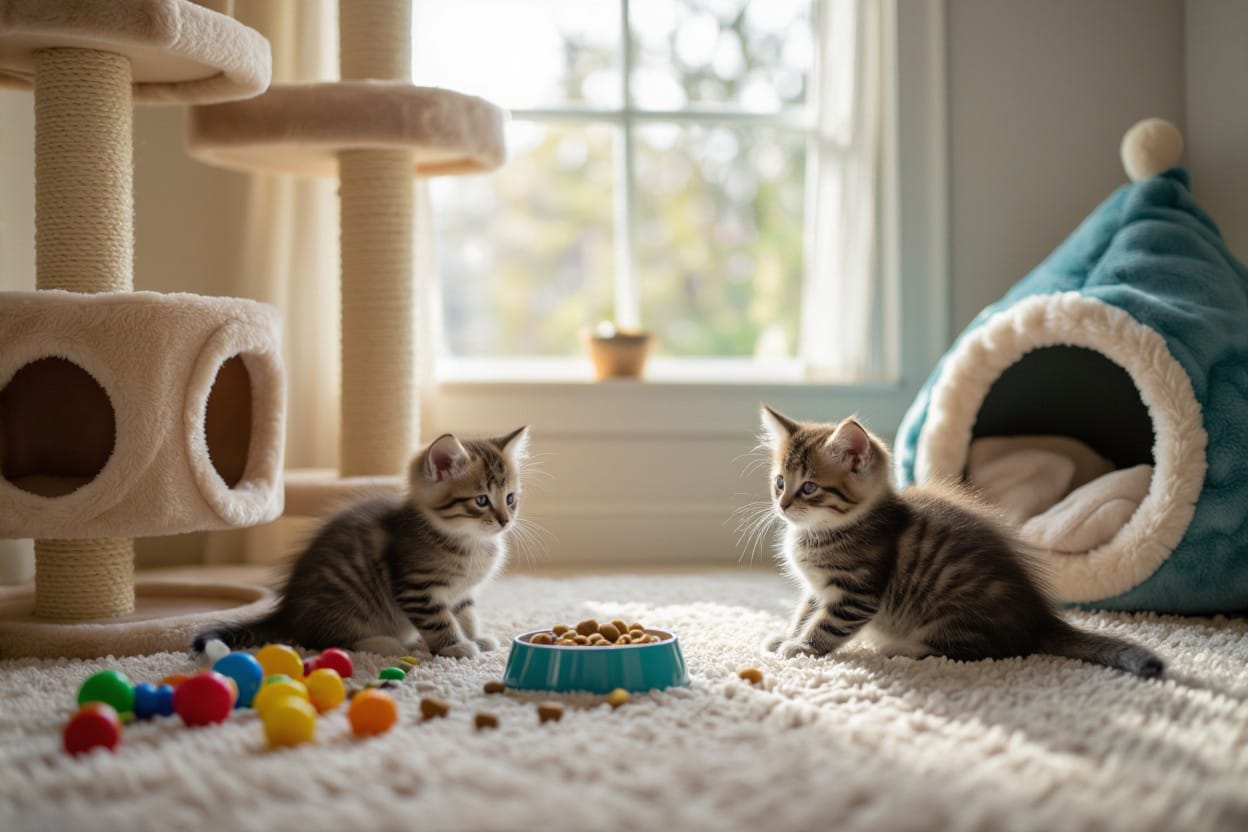
Stage 4: Juvenile Period (3-6 Months)
Physical Changes and Growth Patterns
Growth rate remains rapid but less explosive than the neonatal weeks: many domestic kittens weigh approximately 1–2 kg (2.2–4.4 lb) at 3 months and often reach around 3–4 kg (6.6–8.8 lb) by 6 months, depending on breed and sex. Expect continued muscle development, longer limbs, and refinement of coordination; many kittens achieve roughly 60–80% of adult size by six months, with larger breeds taking longer to fill out.
Permanent teeth erupt across this window, usually finishing by 6 months, so you may see increased chewing and mild gum sensitivity—provide durable chew toys and frozen damp washcloths to soothe teething. Plan spay/neuter and discuss timing with your vet: females can cycle as early as 4 months, so scheduling surgery or preventing pregnancy before sexual maturity is important for health and population control.
Behavior and Social Interaction
Play becomes focused and predatory: your kitten practices stalking, pouncing, and object manipulation with high energy bursts—expect multiple daily sessions of intense play lasting 10–20 minutes. Structured interaction builds bite inhibition and manners; use wand toys and puzzle feeders to channel hunting drive and reduce rough play directed at your hands. Regular kitten socialization still matters, so expose your cat to different people, household noises, and safe animals in controlled, positive sessions of 5–15 minutes.
Social hierarchy with other pets may emerge during this period—supervise introductions and look for signs of stress (hissing, flattened ears, prolonged hiding). Litter box habits usually consolidate, but territorial marking can start in sexually intact kittens; both are manageable with proper training and environmental enrichment. Keep your kitten indoors or supervised outdoors until vaccinations and parasite control are complete (typically around 16 weeks) to avoid disease and injury.
To read and shape social behavior, watch for tail position and pupil size: a puffed tail with sideways ears often signals defensive escalation and requires immediate separation and calm reintroduction later. Redirect play-biting immediately to toys and provide time-outs of a few minutes if your kitten escalates—consistent responses across caregivers accelerate learning.
Training and Development Strategies
Short, frequent training sessions work best: aim for 3–5 sessions per day of 2–5 minutes focused on one goal (litter, recall, calm greetings). Use tiny high-value treats (pea-sized) and clicker timing within one second of the desired action to reinforce behaviors; kittens learn simple cues like “come,” “sit,” and targeting within a week of consistent practice. Provide multiple litter boxes (one per floor plus one extra) and keep them cleaned daily to prevent avoidance.
Environmental enrichment reduces problem behaviors: install vertical spaces, scratching posts (both horizontal and vertical), and rotating toys to maintain engagement. Leash and harness introduction can begin now with short indoor sessions: let your kitten wear the harness for 1–5 minutes initially, then build to supervised exploration. Avoid punitive measures—use redirection and positive reinforcement to shape preferred responses, and remove or secure hazardous items such as loose cords and small ingestible objects.
For measurable progress, outline a 2-week plan: Day 1–3 habituate to clicker and treats; Day 4–7 teach a one-step cue (target or sit) in 3–5 short reps per session; Week 2 add duration and generalization (different rooms, soft distractions). Consistency across caregivers and timed rewards will make these techniques effective for playful kittens and ongoing kitten development.
Stage 5: Adolescent Period (6-12 Months)
Final Physical Changes and Maturity
Between 6 and 12 months your kitten will complete most rapid growth: permanent teeth are usually in by 6 months, growth plates begin closing around 9–12 months, and many medium-sized breeds reach adult weight (commonly 8–11 lb) by one year. Larger breeds such as Maine Coons often continue filling out past 12 months and may not reach full size until 18–24 months, so adjust feeding and exercise plans by breed.
Sexual maturity commonly appears between 5–9 months; intact females may go into heat and intact males often begin roaming or spraying. Spaying or neutering at around 4–6 months reduces unwanted litters and, if done before the first heat, can lower mammary tumor risk by up to 90%. Monitor for signs of heat, sudden roaming attempts, or increased urine scenting and act promptly to protect health and household stability.
Behavioral Establishment and Independence
Play patterns solidify into adult routines during this stage: expect bursts of high energy alternating with long naps (kittens still sleep 16–20 hours daily). You should run structured play sessions 2–3 times per day, 10–15 minutes each, using wand toys and puzzle feeders to channel hunting drive and reduce unwanted biting or furniture attacks. Socialization remains effective past 12 weeks—continue controlled introductions to new people, dogs, surfaces, and sounds to refine your kitten’s confidence.
Independence shows as your kitten tests boundaries: jumping on counters, selective litter box lapses, or ignoring commands. Use consistent rules, reward-based training (clicker or treat-based), and set up at least one vertical territory per living area so your kitten can retreat and observe without confrontation. Redirect rough play to interactive toys rather than letting them practice on your hands or feet—this prevents habituation to biting and scratching.
Example approach: if your 8-month-old becomes pushy during greetings, stop interaction for 20–30 seconds when biting starts, then resume only when calm; pair calm behavior with high-value treats to shift expectation. Continued kitten socialization paired with routine reduces anxiety-driven behaviors and builds a reliably playful, well-adjusted adult.
Managing Adolescent Challenges
Adolescent testing can produce scratching, nighttime zoomies, door-dashing, and selective litter use. Provide multiple scratching posts (one per vertical zone), secured tall perches, puzzle feeders, and scheduled meals to stabilize energy and reduce destructive behavior. For training, short consistent sessions using positive reinforcement beat punishment—avoid physical corrections that increase fear or aggression.
Risky behaviors like roaming or fighting increase exposure to trauma, parasites, and infectious disease; microchip your cat, keep vaccinations current, and consider supervised outdoor access or a catio. If spraying or persistent aggression appears in an intact cat, neutering reduces spraying frequency substantially and, combined with environmental enrichment, often resolves escalation.
Practical fix for nighttime activity: play one vigorous session (5–10 minutes fast-paced play, then 5–10 minutes slower stalking play) about 30–60 minutes before bed, follow with a small meal, and provide a cozy elevated sleep spot. Apply this routine consistently for 1–2 weeks and track reductions in night disturbances.
Month-by-Month Care Calendar
Months 1-2: Early Essentials
Expect weight to double in the first week and continue steady gains of about 10–20 g per day after that; weigh your kitten daily in week one and then every few days to catch failure to thrive early. Bottle-feed orphaned kittens every 2–3 hours in week one, moving to every 3–4 hours by week two; start offering shallow gruel of kitten-formula-mixed wet food at ~4 weeks to begin weaning. Litter training usually starts naturally by 3–4 weeks—place the kitten in a shallow box with unscented clumping litter after meals and naps to reinforce the habit.
Keep ambient temperature at 30–32°C (86–90°F) in week one, dropping gradually to room temperature by week four; use a safe heat source and check skin temperature to avoid hypothermia or burns. Begin a deworming schedule at 2, 4, 6, and 8 weeks per common protocols, and plan your first vet check and FVRCP assessment around 6–8 weeks to screen for congenital issues and start vaccinations.
Month 3: Socialization and Vet Visits
Month three is prime time for deliberate socialization—introduce short, controlled interactions with different people, gentle handling of feet, ears and mouth, and supervised exposure to calm dogs if available; these steps shape playful kittens that tolerate grooming and vet visits. Continue booster vaccinations every 3–4 weeks until 16 weeks, check fecal tests for parasites, and discuss flea prevention and microchipping with your vet during this visit.
Channel predatory drive into structured play: aim for three 10–15 minute wand-toy sessions daily, teach bite inhibition by stopping play when your kitten bites hands, and offer puzzle feeders to develop problem-solving and reduce destructive behaviors. If you plan to rehome or foster, kittens handled at least a few times daily in diverse settings show measurably lower fear responses by 12 weeks and higher adoption rates in shelter studies.
Specific vet red flags to act on immediately include persistent sneezing, nasal or ocular discharge, labored breathing, or poor appetite; call your clinic if these appear between visits—early treatment of URI or parasitic burdens prevents setbacks in socialization and growth.
Months 4-12: Milestones and Key Focus Areas
Between 4 and 6 months you’ll see rapid coordination, most adult teeth erupt by ~6 months, and sexual maturity can appear as early as 5 months in some breeds—plan spay/neuter around 4–6 months based on your vet’s advice to prevent unwanted behaviors like roaming or spraying. Adjust feeding to 3 meals per day until 6 months, then transition to twice daily; many kittens reach ~80–90% of adult size by six months, but growth plates and behavior continue developing through 12 months.
Focus on advanced training and enrichment: introduce vertical spaces, scratching posts of different textures, scheduled interactive play to prevent boredom, and gentle tolerance training for nail trims and dental care. Complete vaccine series by 16 weeks, maintain monthly parasite prevention, and schedule a 6- to 12-month wellness exam to reassess diet, behavior issues, and training progress.
Use a simple timeline: 4 months—more independence and increased play intensity; 6 months—finish primary dental development and most vaccines, spay/neuter window often scheduled; 9–12 months—solidify daily routine, finalize diet transition to adult food at ~12 months unless otherwise indicated by breed or vet, and continue social play to keep your kitten a friendly, well-adjusted cat.
Common Behavioral Issues and Solutions
Litter Box Problems
Many kittens learn elimination from their mother between 3–6 weeks, but you’ll still see accidents during the 0–12 month development window as they test textures and locations. Offer one litter box per cat plus one extra, use a low-entry box for young kittens, and select unscented clumping litter—scoop daily and perform a full clean weekly to match feline preference for cleanliness. If your kitten consistently avoids the box, move a clean box to the soiled spot for a few days to retrain the association, and place the box near where the kitten naps and eats to increase use.
Sudden changes in litter-box behavior warrant diagnostic attention: straining, frequent attempts, vocalizing while urinating, or visible blood are signs of urinary tract infection, blockage, or other medical issues—seek veterinary care immediately. Behavioral causes include stress from a new household member, a box in a noisy area, or physical inability to climb into the box; confine the kitten to a small safe area with proper litter access while you troubleshoot and work on kitten socialization to reduce anxiety-driven avoidance.
Excessive Vocalization
Kittens vocalize to communicate hunger, attention needs, discomfort, and during developmental stages—breeds like Siamese are genetically more talkative. Establish a consistent feeding routine (for example, measured meals 3–4 times daily for young kittens), schedule interactive play sessions of 15–20 minutes twice daily, and introduce puzzle feeders so vocal requests for food decrease. If your kitten meows persistently at night, avoid reinforcing the behavior by responding with attention; instead, provide a predictable bedtime routine and pre-sleep play to expend energy.
Medical causes include pain, respiratory issues, or hormonal behaviors as sexual maturity approaches around 4–9 months; spay/neuter typically reduces hormonally driven yowling. Track the pattern: note time of day, triggers, and any changes in tone—high-pitched, continuous calls paired with lethargy or loss of appetite require urgent veterinary evaluation.
Separation-related meowing often stems from early weaning or insufficient kitten socialization during the 2–14 week window; use gradual desensitization—leave for short intervals and increase duration, provide a warm safe den, and try pheromone diffusers to lower anxiety. Enrichment for playful kittens, such as rotating toys and cat trees, reduces boredom-based vocalizing while supporting healthy kitten development.
Aggressive Behaviors
Play aggression is the most common form in kittens: pouncing, biting, and scratching during high-energy play. Redirect this by offering wand toys and chase toys so the target is the toy, not your hands; when a hard bite or scratch occurs, stop interaction and give a 30–60 second time-out to teach consequence. Implement multiple short play sessions (two to three 10–15 minute sessions daily) to burn off excess energy and reinforce gentle play with treats and praise when your kitten uses toys instead of hands.
Redirected aggression can happen when a kitten is overstimulated by an outdoor cat or sudden noise and lashes out at you or a housemate. Calm the environment by removing the trigger, provide vertical escape options like shelves or trees, and use structured socialization exercises to teach coping skills. If aggression is sudden, severe, or escalating despite consistent training, consult your veterinarian to rule out pain and consider a veterinary behaviorist for tailored modification plans.
Acute onset aggression paired with other signs—limping, avoidance, changes in grooming, or appetite loss—often indicates underlying medical causes such as dental pain, ear infection, or injury; seek veterinary assessment promptly. Intact males around 6–9 months can show increased territorial aggression, and spay/neuter along with behavior modification reduces long-term risk to humans and other pets.
Health Concerns to Monitor
Common Illnesses in Kittens
Upper respiratory infections (caused by feline herpesvirus and calicivirus) show up as sneezing, ocular or nasal discharge, and decreased appetite; in shelter and multi-cat settings prevalence can reach 60–80% during outbreaks. Feline panleukopenia (FPV) remains one of the most dangerous threats for unvaccinated kittens—mortality rates can approach up to 90% in young, untreated animals—so watch for sudden vomiting, bloody diarrhea, and severe lethargy.
Internal parasites like roundworms and hookworms frequently infect kittens and cause pot-bellied appearance, persistent diarrhea, and weight loss; you should deworm starting at about 2 weeks and follow vet-recommended intervals. External parasites and skin issues—fleas that can cause life-threatening anemia in kittens under 8 weeks, ear mites, and ringworm (a zoonotic fungal infection that can infect your family)—also demand prompt treatment.
Preventative Health Measures
Follow a pediatric vaccination schedule: start the FVRCP series at 6–8 weeks, boost every 3–4 weeks until at least 16 weeks, and give rabies per local law (often at 12–16 weeks). Consider FeLV testing and vaccination for kittens with outdoor access or unknown exposure; FeLV vaccine typically begins at 8–12 weeks with a booster 3–4 weeks later.
Use kitten-safe parasite control and dewormers labeled for the kitten’s age and weight—common regimes deworm at 2, 4, 6, and 8 weeks then monthly until 6 months. Spay or neuter between 4–6 months (some vets at 8–16 weeks) to reduce unwanted litters and long-term disease risk; microchipping during a routine procedure improves chances of reunification if your kitten slips outside.
Maintain environmental hygiene: launder bedding frequently, clean litter boxes daily with hot water and mild detergent, and quarantine new or sick cats for at least 2 weeks to reduce URI and parasite spread. Stress reduction and supervised play with safe toys support healthy immune function and socialization—important for kitten development and shaping playful kittens into well-adjusted adults.
Importance of Regular Veterinary Care
Schedule the first comprehensive vet exam within the first week after you bring a kitten home, especially if the kitten is younger than 12 weeks; follow-up visits every 3–4 weeks for vaccines and growth checks until the series is complete. Routine weight, hydration, and fecal exams catch problems early—small weight losses of 5–10% in a week can indicate illness that needs immediate attention.
Veterinary visits also detect non-infectious issues: congenital heart murmurs, hip/elbow abnormalities, and early dental disease that can affect long-term quality of life. Keeping a documented vaccine and treatment history helps your vet tailor care plans for behavior and socialization needs, supporting both medical health and kitten socialization goals.
Keep a clear schedule of upcoming shots, deworming, and any prescribed flea/tick preventives; your vet can provide a written plan and reminders so you don’t miss critical windows during the rapid 0–12 month development period covered in this kitten care guide.
Nutrition and Feeding Guidelines
Essential Nutritional Needs by Age
Kittens demand a growth-focused nutrient profile: aim for diets with roughly 30–40% protein and 20–30% fat on a dry-matter basis, with added DHA for brain development and adequate taurine for cardiac and retinal health. Newborns feed every 2–3 hours and are typically offered solid food beginning at about 3–4 weeks; by 8–10 weeks most kittens are fully weaned onto wet or moistened kibble designed for growth. Growth-phase diets are formulated to supply up to about twice the energy per kilogram compared with an adult maintenance ration, so follow package kcal guidance and adjust by monitoring body condition each week.
Follow feeding frequency that matches age and activity: offer 3–4 small meals daily from weaning through ~6 months, then transition to 2–3 meals as growth slows. Look for foods labeled “complete and balanced for growth” by AAFCO or equivalent, and check ingredient lists for named animal proteins (chicken, turkey, salmon) and added vitamins/minerals; avoid vague labels like “meat meal” without source specifics. If your kitten is underweight or overactive, increase or decrease portions by 10–15% and recheck weight weekly until you hit a steady gain curve.
Transitioning to Adult Food
Most cats are ready for adult maintenance formulas between about 9 and 12 months of age; larger breeds such as Maine Coons may benefit from growth diets until 18–24 months. Switch based on body composition rather than solely age—if your kitten is lean and still putting on frame, delay the switch. Select an adult formula that maintains adequate protein (at least similar relative protein to growth diets) while lowering total calories to prevent excessive weight gain.
Make the change gradual over 7–14 days to minimize GI upset: start with a 25% new : 75% old mix for days 1–3, move to 50/50 for days 4–7, then 75/25 for days 8–10 before offering 100% adult food. Monitor stool quality, appetite, and energy; soft stools or vomiting during transition indicate you should slow the ratio change and consult your vet. After spay/neuter surgeries expect metabolic rate to drop; reduce daily calories by about 10–20% at that time unless activity increases.
More info: choose adult formulas tailored to lifestyle—indoor adult for lower-energy kittens, weight-management for tendency to gain, and high-protein adult for very active cats. Reassess body condition every month and adjust portion sizes based on kcal-per-day guidelines on the label; most adult maintenance charts provide kcal/kg ranges you can use as a starting point, then fine-tune to your cat’s needs.
Homemade vs. Commercial Diets
Commercial kitten foods formulated to AAFCO growth standards deliver consistent, complete and balanced nutrient profiles and are the simplest way to meet your kitten’s needs. Wet food helps with hydration and is often higher in protein density per serving; dry food can assist dental abrasion but may be higher in carbs—balance the two according to your kitten’s preferences and caloric needs. Look for explicit kitten formulations with listed kcal/serving to manage portion control accurately.
Homemade recipes—cooked or raw—require precise supplementation to avoid serious deficiencies: calcium, phosphorus balance, vitamin D, and taurine must be correct to prevent stunted growth, metabolic bone disease, or cardiomyopathy. Raw diets carry added risks of bacterial contamination (Salmonella, Campylobacter) and parasite exposure; if you choose a noncommercial route, work with a board-certified veterinary nutritionist and follow lab-tested recipes rather than improvising ingredients.
More info: if you pursue homemade feeding, include validated supplements (taurine 100–250 mg/day for kittens as advised by your nutritionist), use calcium carbonate to correct Ca:P ratios, and schedule growth checks and bloodwork every 6–12 weeks during rapid growth. Most owners find a commercial kitten diet plus occasional home-cooked toppers or vet-formulated recipes gives the best balance of safety, nutrition, and practicality.
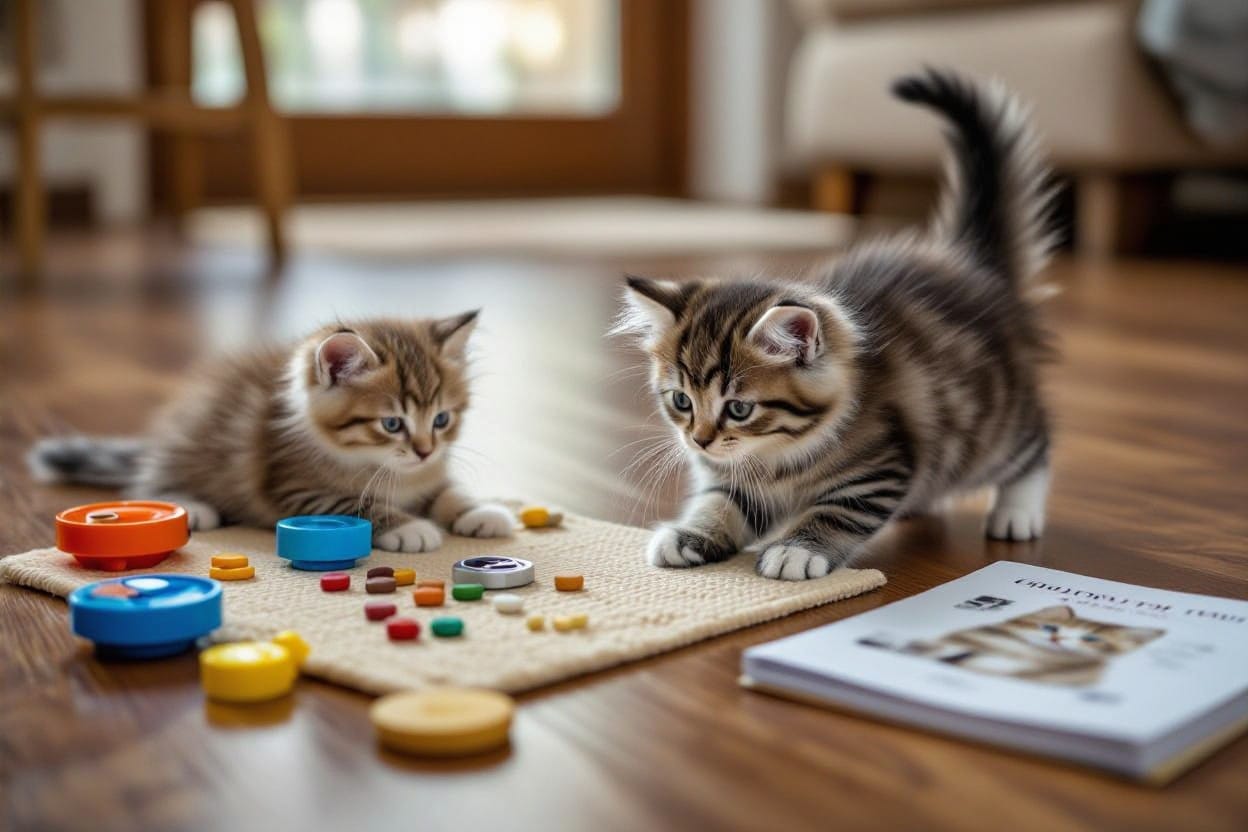
Training Techniques for Kittens
Basic Commands and Socialization
Use short, frequent training bursts—3–5 minutes, 3–4 times daily—to teach your kitten name recognition, “come,” and a basic sit or target touch. Clicker or marker-word training speeds learning: pair the sound with a high-value treat (pea-sized pieces of freeze-dried chicken), mark the exact moment of success, then reward. Most kittens will reliably perform a simple cue after 5–10 consistent sessions; expect variable progress during the 6–12 month adolescent surge in independence.
Prioritize guided socialization alongside command work by exposing your kitten to new people, handling routines, and household sounds in controlled steps. If you see signs of fear (flattened ears, wide pupils, hiding), back up one step and use positive reinforcement to rebuild trust. Redirect rough play or biting to toys immediately; never use hands as play objects because that increases the likelihood of undesirable aggressive play later.
Litter Box and Scratching Post Training
Place at least one litter box per cat plus one extra, with a shallow-sided box for kittens transitioning from nursing to independent toileting. Use unscented, clumping litter for kittens older than 4 months; for very young kittens (under 4–6 weeks) a non-clumping paper-based substrate is safer. Expect most kittens to adopt the box within days if the box location is quiet, accessible, and cleaned daily—scooping twice daily reduces avoidance.
Offer a mix of vertical and horizontal scratching surfaces—sisal-wrapped posts and corrugated cardboard pads—positioned near sleeping areas and sofas to intercept unwanted scratching. Encourage use by rubbing a toy or a small amount of catnip on the post and rewarding your kitten when they scratch the correct surface. Trim nails every 2–3 weeks to reduce damage during training sessions.
Avoid punitive responses like rubbing a kitten’s nose in waste or yelling; those actions increase stress and can create litter-box aversion. If accidents persist, check for medical issues and gradually move the box closer to the kitten’s preferred elimination spot, then slowly relocate it to the desired location by no more than 2–3 inches per day.
- Match box size to kitten growth: start with a 12–16 in shallow box, graduate to a larger covered/uncovered box at 4–6 months.
- Maintain hygiene: scoop twice daily and fully change litter weekly for most brands.
- Provide at least one extra box to reduce stress-related elimination errors.
- Use scratching posts near problem areas and reward successful use immediately.
Box & Scratching Quick Reference
| Item | Action |
| Number of boxes | One per cat + one extra; place on each floor if you have multiple levels |
| Litter type | Unscented clumping after 4 months; paper-based for very young kittens |
| Scratching surfaces | Vertical sisal post + horizontal cardboard pad near favorite spots |
| Cleaning | Scoop ≥2x/day; full change weekly (adjust for odor) |
Advanced Training Strategies
Progress to shaping complex behaviors using successive approximations: break a trick into tiny steps, reinforce each micro-step, then gradually raise your criterion. For example, teach a carrier-mat routine by first rewarding your kitten for looking at the mat, then for stepping on it, then for remaining 2–5 seconds—extend duration by 2–3 seconds per successful repetition until reaching the target behavior.
Introduce harness and leash in staged steps over 7–10 days: let your kitten sniff the harness (day 1), wear it briefly indoors with treats (days 2–4), then practice short leash walks in a quiet yard (days 5–10). Use variable reinforcement once the behavior is >70% reliable—switch from a treat every time to a random schedule (approximate 50–70% rewards) to strengthen long-term retention and reduce treat dependence.
Incorporate concept training (mat stays, door manners, recall with distractions) and generalize behaviors across rooms, carriers, and people. If your kitten regresses during adolescence, lower the difficulty, increase reinforcement frequency for a week, then rebuild complexity. Avoid physical corrections; shaping and differential reinforcement produce faster, safer results.
- Plan sessions of 5–10 minutes, twice daily, for multi-step behaviors.
- Use target sticks or clickers to speed precise responses and reduce ambiguity.
- Fade food rewards to occasional treats and praise once behavior is consistent.
- Generalize commands across contexts: practice at home, in the car, and near visitors.
Advanced Training Breakdown
| Strategy | Implementation |
| Shaping | Reinforce successive micro-steps; increase requirement slightly each session |
| Variable reinforcement | Transition to intermittent rewards after ~70% mastery to maintain fidelity |
| Harness acclimation | 7–10 day gradual protocol: sniff → wear briefly → indoor leash → outdoor short walks |
| Generalization | Practice behaviors in 3+ locations and with different handlers |
Grooming and Hygiene Practices
Bathing and Brushing Techniques
Bath kittens only as needed: most short-haired kittens require bathing rarely, while long-haired breeds like Persians benefit from a bath every 4–6 weeks to prevent matting. Bathe only after 8 weeks of age and once the kitten can regulate body temperature; use a kitten-formulated, pH-balanced shampoo and water at about 37–39°C (98–102°F). Minimize stress by filling a sink with 5–10 cm of warm water, keeping sessions under 5–7 minutes, and immediately wrapping the kitten in a warm towel to dry—failure to dry thoroughly can lead to hypothermia in kittens under 6 months.
Daily brushing for 2–5 minutes prevents tangles in long coats and reduces hairballs; aim for 2–3 minutes every day for long-haired kittens and 5–10 minutes weekly for domestic shorthairs. Use a slicker brush or undercoat rake for dense fur, and a soft-bristle brush or rubber curry for short coats; work in the direction of hair growth and use a metal comb to gently remove small mats—if you encounter a tight mat, use a dematting tool or seek professional help to avoid skin tears. Incorporate brushing into play and post-feeding routines to reinforce positive associations for playful kittens and support kitten socialization.
Dental Care: Importance and Methods
Kitten teeth erupt between 2–6 weeks and permanent teeth arrive around 3–6 months, so start dental habits early to influence lifelong oral health and support overall kitten development. Brushing daily is ideal; use a small, soft-bristled feline toothbrush or finger brush with pet-safe toothpaste (never use human toothpaste). Begin by letting your kitten taste the toothpaste, then progress to gently rubbing the gums and teeth—work toward 1–2 minutes total, 5–7 days a week. Watch for signs that require veterinary attention: persistent halitosis, inflamed or bleeding gums, drooling, or difficulty eating are dangerous symptoms that may indicate periodontal disease or tooth resorption.
Supplement brushing with VOHC-approved dental chews, water additives, or a dental prescription diet as recommended by your vet; these products can measurably reduce plaque and tartar buildup when used regularly. Schedule the first professional oral exam around the time of spay/neuter or at 6 months so the veterinarian can assess tooth alignment and spot early issues; some kittens need prophylactic scaling if plaque accumulates rapidly.
To introduce brushing efficiently: let the kitten lick toothpaste from your finger, then gently rub the outer surfaces of the teeth with a finger or cloth for several days before moving to a brush. Aim to expose each quadrant for 20–30 seconds and build up to 2 minutes total; consistency during this socialization window makes the process easier as the kitten matures.
Nail Care and Grooming Equipment
Trim nails every 10–14 days during the 0–12 month period to prevent overgrowth and reduce destructive scratching as your kitten becomes more active. Use small cat clippers (scissor-style or guillotine) and press the toe to extend the nail; cut only the translucent tip and avoid the pink quick—cutting the quick causes bleeding and pain. For dark nails where the quick isn’t visible, trim tiny amounts (1–2 mm) and stop if you see a dark oval; keep styptic powder or cornstarch on hand to control bleeding if the quick is nicked.
Provide at least two vertical scratching posts and a few horizontal options covered in sisal or cardboard to redirect scratching and protect your furniture; Soft Paws nail caps can be applied every 4–6 weeks for households needing extra protection. A Dremel grinder works well for smoothing sharp tips but introduce it in short, positive sessions—grinders are noisy and can frighten kittens, so pair with treats and progressive desensitization to support kitten socialization and maintain calm during grooming.
Essential grooming tools to keep stocked: a slicker brush and fine-tooth comb, kitten-specific shampoo, small soft toothbrush, feline toothpaste, small cat nail clippers, styptic powder, and a quiet Dremel if you plan to use one; choose compact sizes designed for kittens to improve handling and safety during early grooming sessions.
Interactive Tools for Kitten Owners
Development Tracking Tools
Use a simple weekly log to record weight, feeding amounts, litter-box consistency, play sessions, and social exposures; aim for a weight gain of about 10–15 g per day in early weeks and chart it against a growth curve so you spot plateaus—Luna, a rescue kitten case study, went from 95 g at birth to 600 g by 6 weeks with daily entries and targeted supplemental feeding when gain slowed. Include milestone checkboxes for eyes opening (~7–10 days), teeth eruption (3–4 weeks), weaning (4–8 weeks), and socialization peaks (2–7 weeks extending through 12 weeks) so you can correlate behavior shifts with interventions.
Digital options range from a shared Google Sheet for multi-caregiver households to pet-tracking apps that send reminders for vaccines and weigh-ins; set alerts for weekly weigh-ins during the first 12 weeks, then monthly up to 12 months, and log play targets—most playful kittens benefit from 10–15 minute interactive sessions, 2–4 times daily—to measure progress in social play and bite inhibition.
Health and Wellness Checklists
Create a master checklist with dates and completion boxes for core vaccine series (FVRCP at 6–8, 10–12, and 14–16 weeks), rabies timing per local law (often 12–16 weeks), deworming schedule (start at 2 weeks, repeat every 2 weeks until 8 weeks, then monthly as advised), and a planned spay/neuter window (commonly 4–6 months). Add routine items: microchipping, flea prevention start date, and a behavioral/socialization audit at 8 and 12 weeks to track exposure to people, other pets, and handling.
Include acute-warning checkpoints on the same sheet: failure to gain weight for 48 hours, persistent vomiting/diarrhea beyond 24 hours, labored breathing, seizures, or temperature outside the normal range (under 99°F or over 104°F) should flag an immediate vet visit. Use color-coding—green for on-track, amber for watch, red for urgent—to make the checklist actionable at a glance.
Practical use: print a laminated copy to keep near the carrier and sync dates to your phone calendar for automatic reminders; when you take your kitten to the vet, hand over the filled checklist so your veterinarian sees trends (weight curve, behavioral notes, vaccine reactions) rather than only isolated recollections.
Emergency Resource Guides
Compile a short, printed emergency card with your primary vet, nearest 24/7 emergency clinic, and the national poison control number (in the U.S. ASPCA Animal Poison Control: 888-426-4435) plus directions and estimated drive times; list top household hazards—lilies, xylitol, antifreeze, acetaminophen/ibuprofen—and the immediate signs they cause (drooling, vomiting, tremors, collapse). Keep a small grab-and-go kit in your car or by the door with a padded carrier, clean towel, sterile bandage, disposable gloves, and a printed copy of your kitten’s medical history and vaccine dates.
For common emergencies, note that severe bleeding, trouble breathing, inability to rise, or prolonged seizure activity require urgent transport; call the clinic en route so they can prepare. Avoid inducing vomiting or giving human medications without explicit veterinary instruction, and use the emergency card to quickly convey meds or known allergies to responders.
Store the emergency guide as a contact card in your phone and a laminated copy inside the carrier; rehearse a quick route to the emergency clinic and check kit contents monthly so you can act within minutes when a playful kitten’s curiosity turns hazardous.
Conclusion
With these considerations you can follow a clear kitten care guide that supports steady kitten development from 0–12 months; you should prioritize a consistent feeding and vaccination schedule, structured play sessions for playful kittens, and targeted kitten socialization to build confidence and prevent behavior problems. You will see the biggest gains when you combine physical care with mental enrichment—regular play, gentle handling, and exposure to people and environments shape temperament and adaptability.
As your kitten grows, monitor health and behavior closely and adjust routines to match developmental milestones; consult your veterinarian or a behavior specialist if you notice persistent issues. By staying proactive about nutrition, training, socialization, and safe play, you give your kitten the foundation for a healthy, well-adjusted adult cat and maximize the benefits of this comprehensive kitten care guide.
FAQ
Q: What should I feed a kitten from birth to 12 months?
A: Newborns need kitten formula if the mother isn’t available; feed every 2–3 hours for the first 2 weeks. Begin weaning at 4–5 weeks with a gruel of wet kitten food mixed with formula, moving to high-quality wet and dry kitten food by 8–10 weeks. Feed frequency: 4 times/day until ~3 months, 3 times/day until ~6 months, then 2 times/day until about 12 months. Use food labeled for growth to meet calorie and nutrient needs, avoid cow’s milk, provide fresh water at all times, and adjust portions to maintain steady weight gain—consult your vet for growth tracking and any supplements.
Q: How do I handle kitten socialization during the first year?
A: Start gentle, positive exposure to people, household sounds, handling, and different surfaces as early as 2–7 weeks and continue intensively through 12–16 weeks; ongoing social experiences through 6 months help prevent fear. Use short, calm interactions, play-based introductions, and rewards (treats, praise) so kittens form positive associations. Introduce other vaccinated pets slowly and supervised, and include vet visits, car rides, grooming practice, and crate time to make real-world experiences less stressful. Structured play for playful kittens teaches bite inhibition and acceptable behavior while strengthening your bond.
Q: What are typical kitten development milestones from 0–12 months?
A: 0–2 weeks: rooting, closed eyes and ears; 2–4 weeks: eyes open, first steps; 4–8 weeks: weaning, social play, litter use begins; 8–12 weeks: coordinated running, climbing, advanced play and social learning; 3–6 months: rapid growth, teething, increased exploratory and hunting play; 6–12 months: adolescent energy, territory testing, sexual maturity around 5–8 months (spay/neuter commonly recommended 4–6 months). Expect bursts of growth and changing behavior—structure, consistent training, and appropriate outlets for energy support healthy kitten development.
Q: How do I litter-train, kitten-proof my home, and provide enrichment for playful kittens?
A: Provide one litter box per cat plus one, placed in quiet accessible spots; use unscented clumping litter and shallow boxes for young kittens, scoop daily and change weekly. Kitten-proof by hiding cords, securing windows, removing small ingestible items, and blocking gaps. Enrichment: vertical spaces, scratching posts, puzzle feeders, and a rotation of interactive toys; schedule daily interactive play sessions (10–15 minutes, 2–3 times/day) to channel hunting instincts and reduce misbehavior. Offer safe hiding spots and gradual introductions to new objects to build confidence.
Q: What vaccinations, parasite control, and vet care should I follow in the first year?
A: First vet visit at 6–8 weeks for exam, deworming, and baseline testing; core vaccine (FVRCP) starts 6–8 weeks with boosters every 3–4 weeks until ~16 weeks, rabies per local law (often at 12–16 weeks), and FeLV testing/vaccination if at risk. Start flea and tick prevention and regular deworming per vet guidance; microchipping and spay/neuter are typically done around 4–6 months. Seek immediate vet attention for lethargy, persistent vomiting/diarrhea, breathing problems, refusal to eat, or sudden behavioral changes to protect long-term health.

